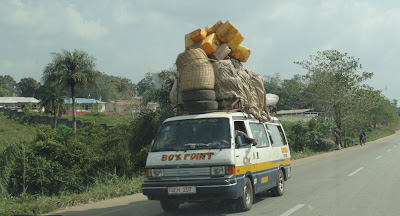As you all know, we use a diesel generator for all of our electricity. We had two generators: the bigger one and a smaller one. We recently purchased a new, larger one. In this picture, it took ten men to move the heavy, smaller one out of the little building before we could bring the larger, new one to the compound. That's Markus holding the pole that they were using to slide it on.
The blue truck delivered the new large generator. The delivery truck brought a good-sized dolly which helped at one end. This thing was Heavy! It took them a lot longer to get it in place.
Finally, they gave up on the dolly and used a board to slide it into the building. A few days later, the building was extended so that the larger generator could function properly and have enough "breathing" room.
The District Relief Society had a picnic for all the sisters. It was a nice gathering for everyone to sing hymns and some African music. Food was shared and fellowship with each other enjoyed. I like these three little girls watching everything and singing along.
As you can see, there is a diversity in dress, age and nationality. Some sisters wear traditional clothing and others are more contemporary. Sister Talbot, the sister in purple, is here with her husband and four children. He is in the US Army and will work at the US Embassy for the next two years. They were kind to let as many missionaries as possible use their telephone for calls home during Christmas.
"This is the way we wash our clothes, wash our clothes, wash our clothes". We have a good size washer and dryer. In order to conserve water, we save the rinse water and use it as our wash water. So, we take the hose from the back of the washer, hook it on the blue plastic trash can. Once it is filled and the last wash ended, we take the bucket (next to the blue trash can) and transfer the water into the wash machine. Sometimes, we'll use the same water for a couple of loads--especially if we washed whites the first load. No complaints from us though; the missionaries wash their laundry in a bucket. Although, some are inventive and find someone to do it for them for about 20 cents. (Put that in perspective: the average daily wage is about $1.50) We were commenting on one of the white shirts an elder was wearing. We asked how he kept it so white (because after a few months, shirts become almost beige with the red sand and dirt in the air), the missionary replied that he always has someone wash for him because it saves his knuckles. :-)
Speaking of laundry, the clotheslines are usually made of three bamboo poles: two at each end and one long one in the middle. Depending where we are, we can see different methods. Sometimes, even the highway will be lined with drying clothes. The sacks are filled with charcoal. It is the foremost source of fuel here in West Africa. All along the highway we will see these sacks full of charcoal to sell. (In this picture, we can see a mosque. They are very common also.)
Lots of yellow plastic containers everywhere. This truck was stuffed to the brim and overflowing out the doors. The yellow containers have either water, palm oil or maybe palm wine in them. We mostly see them filled with water and carried on a yoke on the back of someone.
More yellow containers, baskets, tires and whatever else will stack and tie down on top. Inside probably has about 20 people. This is an excellent example of a "poda" that our missionaries talk about in letters home.
On the backroads heading to Liberia, we see lots of interesting things. These guys hopped a ride on this taxi anywhere they could hang on. We appreciated the fellow holding his shoes knowing it is a very muddy road and bumpy. He didn't want to lose them.
Continuing on down the backroad, another taxi--it is so astounding to us that any portion of the vehicle is used to transport anything or anyone.
We often see sheep and goats along the way down this bumpy road to the Liberian border. One thing we have noticed: In the jungle area, the chickens, goats and sheep are all healthy looking and bigger than in the city areas.
When we stopped for a little break along this four-hour stretch of road, we saw this huge (I think) termite or flying ants' "tree" hive. The tree is probably two feet in circumference and about 20 feet high. The picture doesn't do the size of the hive justice. It was probably about 3 feet long. We didn't linger...
We saw this spider in Liberia; although, we also saw the same thing in Sierra Leone. This guy was the size of my hand with his legs all stretched out like that. If you double click on the picture, you can get a better detail of him.
We saw this big snail outside the mission office. One of the locals with us said that there are much bigger ones than this. Nevertheless, we were impressed!
















1 comment:
So many intersting things! It is amazing how resourceful and inventive we humans can be. Happy New Year!!!
Post a Comment